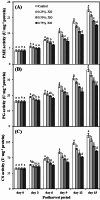Xanthan gum-based edible coating effectively preserve postharvest quality of 'Gola' guava fruits by regulating physiological and biochemical processes
- PMID: 38783216
- PMCID: PMC11112933
- DOI: 10.1186/s12870-024-05117-1
Xanthan gum-based edible coating effectively preserve postharvest quality of 'Gola' guava fruits by regulating physiological and biochemical processes
Abstract
Background: Guava is a fruit prone to rapid spoilage following harvest, attributed to continuous and swift physicochemical transformations, leading to substantial postharvest losses. This study explored the efficacy of xanthan gum (XG) coatings applied at various concentrations (0.25, 0.5, and 0.75%) on guava fruits (Gola cultivar) over a 15-day storage period.
Results: The results indicated that XG coatings, particularly at 0.75%, substantially mitigated moisture loss and decay, presenting an optimal concentration. The coated fruits exhibited a modified total soluble soluble solids, an increased total titratable acidity, and an enhanced sugar-acid ratio, collectively enhancing overall quality. Furthermore, the XG coatings demonstrated the remarkable ability to preserve bioactive compounds, such as total phenolics, flavonoids, and antioxidants, while minimizing the levels of oxidative stress markers, such as electrolyte leakage, malondialdehyde, and H2O2. The coatings also influenced cell wall components, maintaining levels of hemicellulose, cellulose, and protopectin while reducing water-soluble pectin. Quantitative analysis of ROS-scavenging enzymes, including superoxide dismutase, peroxidase, catalase, and ascorbate peroxidase, revealed significant increases in their activities in the XG-coated fruits compared to those in the control fruits. Specifically, on day 15, the 0.75% XG coating demonstrated the highest SOD and CAT activities while minimizing the reduction in APX activity. Moreover, XG coatings mitigated the activities of fruit-softening enzymes, including pectin methylesterase, polygalacturonase, and cellulase.
Conclusions: This study concludes that XG coatings play a crucial role in preserving postharvest quality of guava fruits by regulating various physiological and biochemical processes. These findings offer valuable insights into the potential application of XG as a natural coating to extend the shelf life and maintain the quality of guava fruits during storage.
Keywords: Antioxidant activities; Cell wall degradation; Guava postharvest; Hemicellulose; Hydrocolloid; Pectin; Polysaccharide coating.
© 2024. The Author(s).
Conflict of interest statement
The authors declare no competing interests.
The authors declare that they have no competing interests.
Figures









Similar articles
-
A novel edible coating based on Albizia [Albizia lebbeck (L.) Benth.] gum delays softening and maintains quality of harvested guava fruits during storage.Int J Biol Macromol. 2024 Oct;277(Pt 4):134096. doi: 10.1016/j.ijbiomac.2024.134096. Epub 2024 Jul 26. Int J Biol Macromol. 2024. PMID: 39067721
-
Physicochemical, total phenols and pectin methylesterase changes on quality maintenance on guava fruit (Psidium guajava L.) coated with candeuba wax solid lipid nanoparticles-xanthan gum.Food Res Int. 2017 Nov;101:218-227. doi: 10.1016/j.foodres.2017.08.065. Epub 2017 Sep 4. Food Res Int. 2017. PMID: 28941687
-
Hydrocolloid edible coatings extend shelf life, reduce postharvest decay, and maintain keeping quality of mango fruits (Mangifera indica L.) under ambient storage.J Food Biochem. 2022 Dec;46(12):e14481. doi: 10.1111/jfbc.14481. Epub 2022 Oct 13. J Food Biochem. 2022. PMID: 36226773
-
Potential of Aloe vera gel coating for storage life extension and quality conservation of fruits and vegetables: An overview.J Food Biochem. 2021 Apr;45(4):e13640. doi: 10.1111/jfbc.13640. Epub 2021 Feb 3. J Food Biochem. 2021. PMID: 33533511 Review.
-
Recent advancements in polysaccharides, proteins and lipids based edible coatings to enhance guava fruit shelf-life: A review.Int J Biol Macromol. 2024 Mar;262(Pt 1):129826. doi: 10.1016/j.ijbiomac.2024.129826. Epub 2024 Jan 29. Int J Biol Macromol. 2024. PMID: 38296124 Review.
Cited by
-
Genetic diversity and comprehensive evaluation of physicochemical traits in Phyllanthus emblica L. for breeding and resource utilization.BMC Plant Biol. 2025 Sep 2;25(1):1187. doi: 10.1186/s12870-025-07161-x. BMC Plant Biol. 2025. PMID: 40898031 Free PMC article.
-
Improving Guava Shelf Life and Preserving Postharvest Quality With Edible Coatings.Food Sci Nutr. 2025 Jun 20;13(6):e70491. doi: 10.1002/fsn3.70491. eCollection 2025 Jun. Food Sci Nutr. 2025. PMID: 40548187 Free PMC article.
-
Effect of Xanthan gum-based edible coating enriched with cloves and cinnamon for extending the shelf-life of pomegranate fruit during cold storage.Sci Rep. 2025 Aug 27;15(1):31518. doi: 10.1038/s41598-025-15467-x. Sci Rep. 2025. PMID: 40858726 Free PMC article.
-
Enhancing Mexican lime (Citrus aurantifolia cv.) shelf life with innovative edible coatings: xanthan gum edible coating enriched with Spirulina platensis and pomegranate seed oils.BMC Plant Biol. 2024 Sep 30;24(1):906. doi: 10.1186/s12870-024-05606-3. BMC Plant Biol. 2024. PMID: 39350034 Free PMC article.
-
Prevention and inhibition of post-harvest browning in longkong pericarp using Prunus Persica resin coating during ambient storage.PLoS One. 2025 May 12;20(5):e0323416. doi: 10.1371/journal.pone.0323416. eCollection 2025. PLoS One. 2025. PMID: 40354483 Free PMC article.
References
-
- Lobstein A. La «Pharmacie De Charité» De Waldersbach, à L’initiative D’un Pasteur-Herboriste Du XVIIIe siècle. Phytotherapie. 2005;3:125–9. doi: 10.1007/s10298-005-0086-x. - DOI
-
- Germano TA, Aguiar RP, Bastos MSR, Moreira RA, Ayala-Zavala JF, de Miranda MRA. Galactomannan-carnauba wax coating improves the antioxidant status and reduces chilling injury of ‘Paluma’ guava. Postharvest Biol Technol. 2019;149:9–17. doi: 10.1016/j.postharvbio.2018.11.013. - DOI
-
- Jacomino AP, Martínez Ojeda R, Kluge RA, Scarpare Filho JA. Conservação de goiabas tratadas com emulsões de cera de carnaúba. Rev Bras Frutic. 2003;25:401–5. doi: 10.1590/S0100-29452003000300010. - DOI
MeSH terms
Substances
Grants and funding
LinkOut - more resources
Full Text Sources
Miscellaneous

